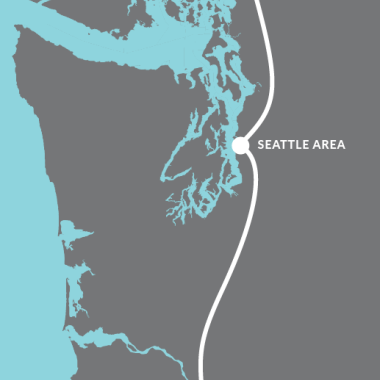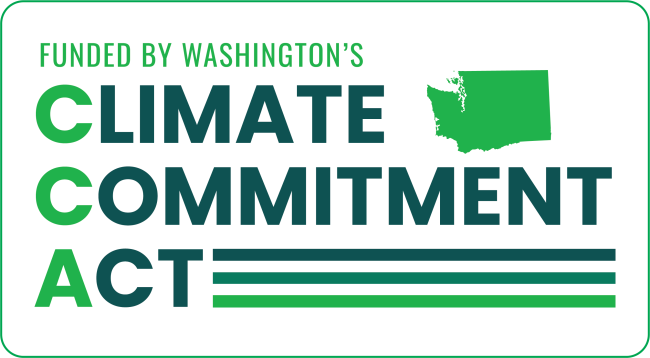WSDOT is studying ultra-high-speed ground transportation
The Washington State Governor’s Office and state Legislature asked WSDOT to study ultra-high-speed rail from Vancouver, British Columbia to Portland, Oregon. Regional business and government leaders believe enhanced interconnectivity would allow Cascadia to better manage the megaregion’s population and economic growth potential and maximize public transportation benefits. Such a system is envisioned to be about much more than transportation. It also could result in better access to jobs, affordable housing, shared resources, increased collaboration and economic prosperity.
The high-speed rail project is intended to create a seamless journey through the megaregion that complements Interstate-5, Amtrak Cascades service, existing and in developing regional transit systems, and air mobility service.
Megaregions
There are 11 emerging megaregions in the United States. Megaregions are networks of metropolitan regions with shared economies, infrastructure and natural ecosystems. The rapidly growing economy and population characterizes the Cascadia megaregion, which encompasses Vancouver, BC; Seattle, Washington; and Portland, Oregon.
Where high-speed ground transportation works best
In general, high-speed rail can be considered feasible where these criteria are present:
- The area being considered should be a megaregion with stops in cities or metro areas with larger populations (Vancouver - Seattle - Portland).
- The travel distance should be between 100-500 miles (Vancouver to Portland is around 350 miles).
- The system should be interconnected with regional and local transit.
- The metropolitan should have economic productivity.
- The system should be used to relieve congested areas (both auto and air).
A high-speed rail system won’t stop everywhere in this corridor. High-speed rail will benefit the entire Cascadia megaregion, not just people at future station stops. It could alleviate traffic and transit congestion while encouraging greater regional collaboration in research, economic development and business innovation.
Current regional connectivity
The Pacific Northwest Rail Corridor (PNWRC) is one of 11 federally designated high-speed rail corridors in the U.S. The 462-mile (742-kilometer) PNWRC serves the most densely populated areas of the Cascadia megaregion, linking Vancouver, BC to Seattle, Portland and Eugene.
High-speed rail is not intended to replace the Amtrak Cascades intercity passenger rail system funded by WSDOT and ODOT. It would be an additional travel option and would serve to promote ridership through connections to other travel modes. Amtrak Cascades trains might connect smaller cities to the high-speed system and they might even share the same new tracks. Because Amtrak Cascades trains currently share tracks with freight trains, it is likely not possible to offer ultra-high-speed service on most of the current Amtrak Cascades routes. Amtrak Cascades trains travel at 79 mph and serve 18 cities in Canada, Washington and Oregon - more than an ultra-high-speed option would serve.
Opportunities for better connectivity
The distances between Portland and Seattle and between Seattle and Vancouver are less than 200 miles (322 km) each, which are short distances for plane trips and longer than necessary for car trips because of congestion. A high-speed rail system could offer speeds up to 250 mph (402 km/h), allowing for travel times of less that an hour between each of the cities.
2016
Governor Jay Inslee and British Columbia Premier Christy Clark sign agreement to explore high-speed transportation system
2017
Feasibility study was submitted to the state Legislature.
2018
An economic impacts addendum was added to the final report document.
2019
The business case study analysis was submitted to the Washington State Legislature.
2020
The 2020 Framework for the Future report was submitted to the Washington State Legislature.
2023
Project accepted into the Federal Railroad Administration Corridor Identification and Development (CID) grant program.
2024
Federal Railroad Administration awards the project CID grant funding to begin service development planning.
Corridor Identification and Development Grant Program - Federal Railroad Administration
The project was awarded a $49.7 million Corridor Identification and Development Program grant from the Federal Railroad Administration in December 2024. The project will also receive $5.5 million in Climate Commitment Act funds as state match from the Washington State Legislature.
Climate Commitment Act
As of 2022, this study is supported with funding from Washington’s Climate Commitment Act. The CCA supports Washington’s climate action efforts by putting cap-and-invest dollars to work reducing climate pollution, creating jobs, and improving public health. Information about the CCA is available at www.climate.wa.gov.
2023-24 budget
The project was awarded a $500,000 grant from the Federal Railroad Administration in December 2023. This Corridor Identification and Development (CID) grant award unlocks $50 million in allocated state matching funds for Cascadia HSR this biennium. Moving through the CID program will provide access to federal funding without having to re-apply and access to an additional $100 million in identified state match funds in future biennia.
2022 budget
During the 2022 legislative session, the Washington State Legislature allocated $4 million for additional analysis and development of an expanded framework for future high-speed rail, and $150 million to be used as matching funds to leverage federal funding opportunities over the next six years.
2020 budget
This $895,000 study was funded by approximate equal contributions from Washington, Oregon, British Columbia and Microsoft Corp.
2018-2019 budget
The study was funded with $750,000 from the Washington State Legislature and an additional $650,000 from the Province of British Columbia, the Oregon Department of Transportation and Microsoft Corp.
2017 budget
The 2017 feasibility study funded with $300,000 from the Washington State Legislature. Microsoft and labor unions also contributed funds to conduct a more in-depth economic impact study.
2020 Ultra-High-Speed Ground Transportation study report
The outcomes of the 2020 UHSGT Framework for the Future report recommends actions in three areas crucial to future decision-making:
Governance framework
This offers guidance to create a coordinating entity to advance the project beyond the initial concept phase and outlines a more formal governing model for the future.
Strategic Engagement Plan
This emphasizes the importance of:
- A robust, deep, and equitable engagement approach with the public.
- Tribes and Indigenous communities.
- Elected officials.
- State, provincial and federal agencies.
- Business and labor leaders.
- Advocacy organizations.
Financial strategy
This sets forth potential strategies to secure a variety of funding sources and includes scenarios for possible federal, state or provincial, and private investments that could create a complete funding and financing plan.
2020 Framework for the Future - Executive summary (PDF 7.5MB)
2020 Framework for the Future - Full report (PDF 8.5MB)
Ultra-High-Speed Ground Transportation study - 2019 business case analysis
The outcome of the 2019 Business Case Analysis builds on previous UHSGT studies conducted by WSDOT. It provides a more comprehensive and detailed picture of the wide range of benefits that would flow to the region due to UHSGT.
The 2019 Business Case Analysis builds on previous UHSGT studies conducted by WSDOT. It provides a more comprehensive and detailed picture of the wide range of benefits that could result in the region due to UHSGT. Details on the strategic, economic, environmental and financial case for UHSGT in the Cascadia megaregion are included.
2019 UHSGT Business Case Analysis – Executive Summary (PDF 388KB)
2019 UHSGT Business Case Analysis – Full Report (PDF 22MB)
Key findings of this study include:
- Less than one-hour trips between each city — Portland, Seattle, Vancouver — at about 220 mph (354 kph).
- Various scenarios with 21 to 30 daily round trips, with some express trips stopping at only a few locations, interspersed with others that stop at more locations.
- Ultimate potential to carry 32,000 people an hour using capacity to schedule many more trains.
- Estimate between 12 and 20 percent of total current intercity trips would shift to UHSGT.
- Estimate conservatively between 1.7 and 3.1 million riders annually when it opens.
- Estimate annual revenue of between $160 and $250 million when it opens.
- Can be built within the 2017 estimate of $24 billion to $42 billion in up-front construction costs.
- Estimate $355 billion in economic growth and 200,000 new jobs related to construction and ongoing operation of the service.
- Reduction of 6 million metric tons (tonnes) of CO2 emissions over first 40 years and potential for zero emissions by using clean energy sources (hydro, wind, solar).
Cascadia High-Speed Rail and I-5 Program Team
CascadiaProgram@wsdot.wa.gov
There is not a public comment period for this project at this time. However, please complete the feedback form if you have questions or would like to share your ideas.


